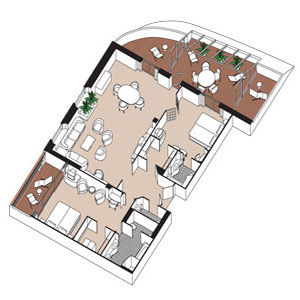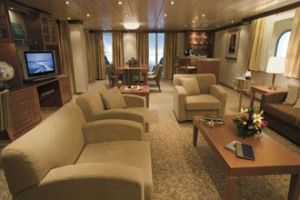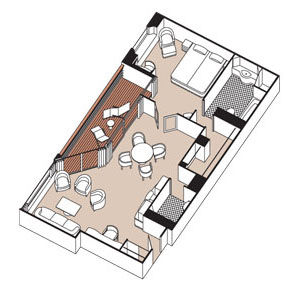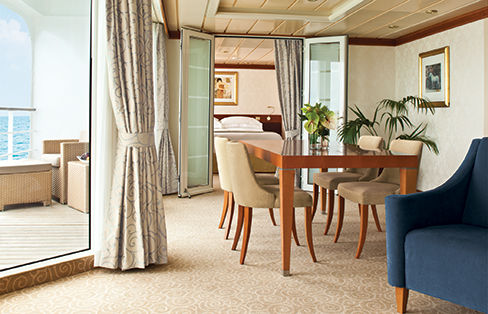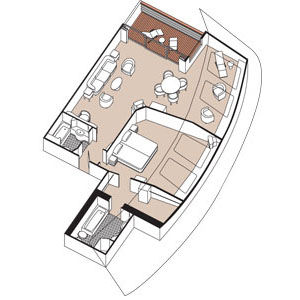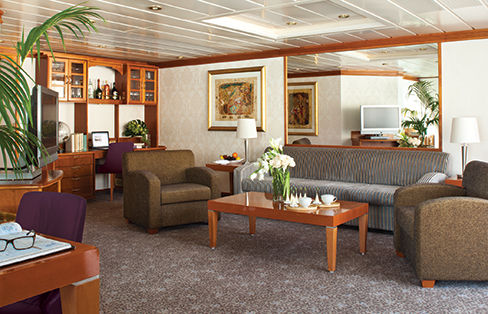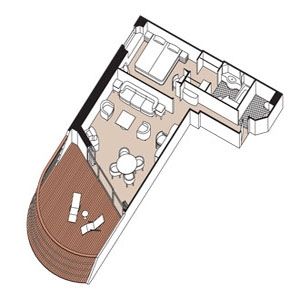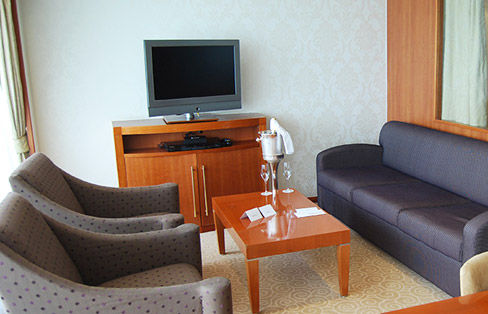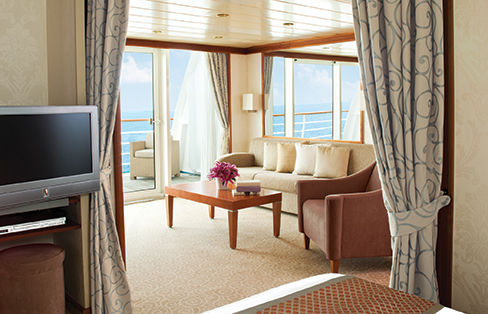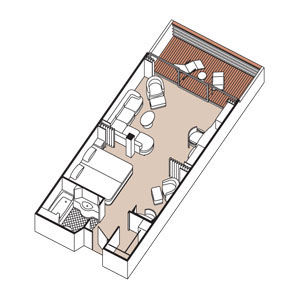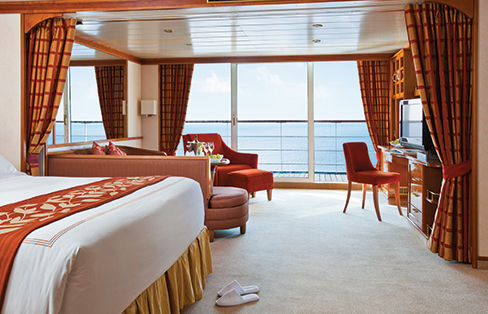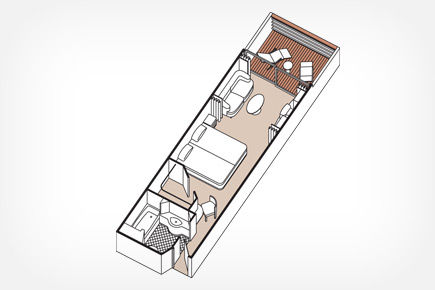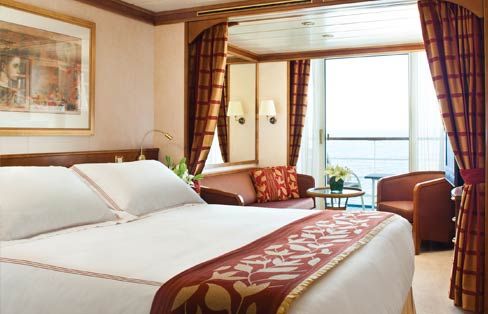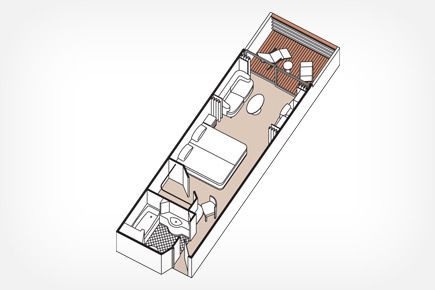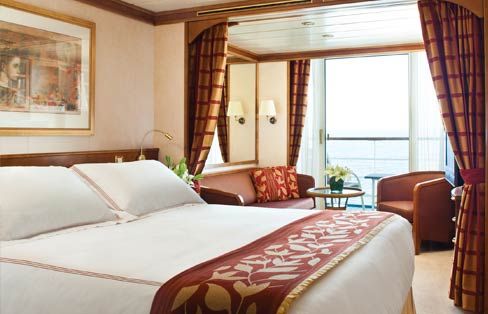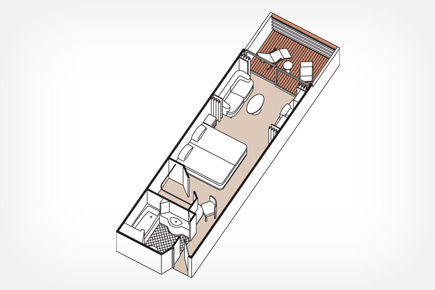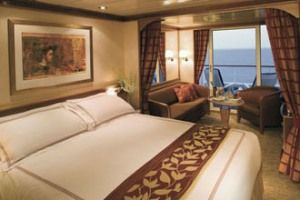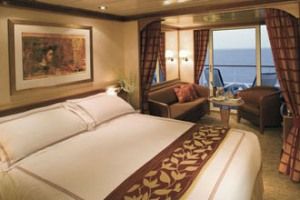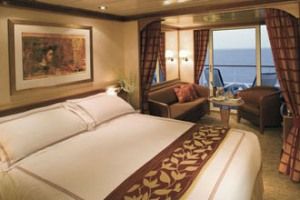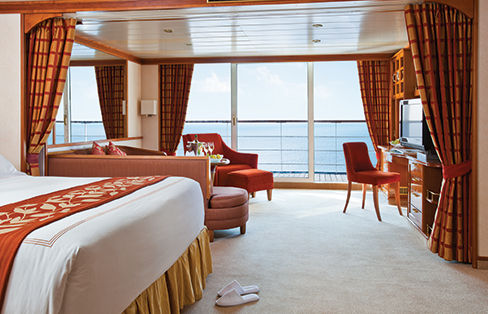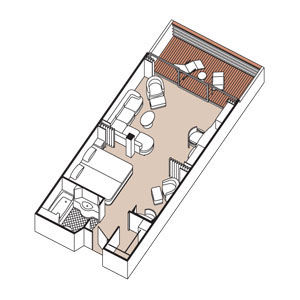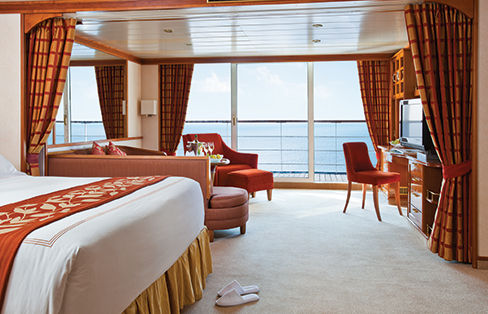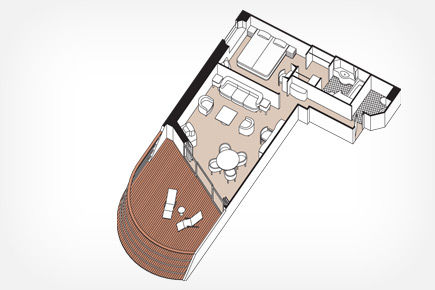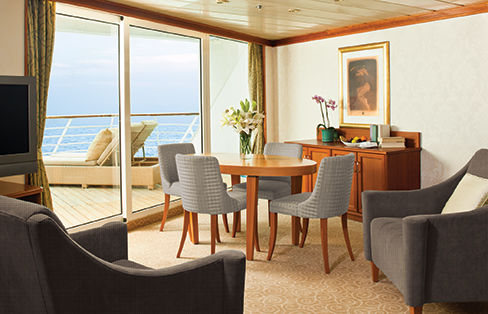Mariner, 150 Nights Navigate The World (away In Wonder) ex Miami to San Francisco – 07/01/2025
150 nights onboard Seven Seas Mariner from Regent Seven Seas Cruises departing 07 Jan 2025
150 nights onboard Seven Seas Mariner from Regent Seven Seas Cruises departing 07 Jan 2025
Philipsburg, St. Maarten
St. Maarten is the smallest piece of land shared by two sovereign states. Legend has it that the Dutch and French boundaries of the island were determined by two men who challenged one another in a race around the island, with the Frenchman walking faster and claiming more land. Legend or not, both the Dutch and French settled here in the 1630s and despite occupancy by the British twice, the Dutch and French have lived peacefully together ever since they arrived.
Roseau, Dominica
Roseau, a small town with plenty of colonial charm, offers the colorful New Market, where you can stop for a refreshing coconut drink. Dominica’s real beauty lies in its unspoiled natural landscape – the dense rain forests, lush foliage, natural springs and rivers and tall, smoldering peaks. Dominica is home to one of the Caribbean’s great natural wonders-the scenic Valley of Desolation, where in a verdant tropical gorge, white mists from bubbling hot springs swirl in the air.
Bridgetown, Barbados
The island of Barbados is rimmed with mile after mile of pristine beaches. The eastern edge, rugged and hilly, lies on the Atlantic Ocean. The west coast, washed by the calmer leeward sea has most of the resort hotels. It is here that you will find the capital, Bridgetown, and older colonial settlements. Tour the meticulously restored 17th-century Sunbury Plantation House or admire the spectacular views from Gun Hill Signal Station. Adventures abound at sea by catamaran or Atlantis submersible and on land by an off-road island safari. Not to miss delicacies include the sweet and tender flying fish, washed down with a glass of Barbados’ famous Mount Gay rum.
Devil’s Island, French Guiana
French Guiana is best known for the infamous penal colony to which convicts and undesirables were deported from France. For a long time the small archipelago was known by the name of “Devil’s Island.” The notorious convict settlements were built in 1852. Today, discover a lush, green landscape, where tropical foliage has grown over the old prison buildings and softened their aspect from forbidding to quaint. The most famous prisoners were Alfred Dreyfus, the French Army officer falsely convicted of treason, and Henri Charrière, who was immortalized in the movie “Papillon” for supposedly being the only convict to escape from “the Green Hell.” Please be advised that due to the under-developed nature of this destination, organized tours are not available.
Belém (Icoaraci), Brazil
The busy port of Belém, Brazil is the gateway to the Amazon, and it is laden with jungle riches like hardwoods, orchids, nuts and minerals. It is known as the Metropolis of the Brazilian Amazon region, or Cidade das Mangueiras (city of mango trees) due to the number of those trees found in the city. Belém offers colorful markets, including indigenous handicrafts and quartz jewelry. Nearby is the emerald world of the Amazon’s Guama River.
Recife, Brazil
Discover colonial Brazil in Recife and nearby Olinda and step back in time along narrow, winding streets amid meticulously restored homes, churches and lovely plazas. Admire the scenic views from the Malakoff Tower and Olinda’s hilltop plaza. Visit the old Dutch Fort, the Jewish Historic Archive and a local artist in his workshop and gallery. Take home lovely traditional Pernambuco handicrafts like clay figurines, wood sculptures, leather or woven straw items or hunt for unusual trinkets in artisan shops. Indulge in a delicious lobster lunch or just about anything your palate desires.
Salvador, Brazil
The oldest and most historic city in Brazil is renowned for its deeply rooted Afro-Brazilian culture. With an amazing number of magnificent baroque colonial-style churches, Salvador has been nicknamed the ‘Black Rome.’ Many of the most interesting museums and churches are located in the Cidade Alta. Surrounding Pelourinho Square, tour bright, multi-colored houses, cobbled streets and aromatic markets.
Búzios, Brazil
The tiny fishing village of Búzios, just 105 miles from Rio de Janeiro, is considered one of the ten most beautiful spots in the world. The village burst into prominence when French actress Brigitte Bardot visited here in her heyday (there’s a statue of her looking out to sea on the Orla Bardot). Today, this once sleepy village is an international resort — St. Tropez, with a unique Brazilian beat. Búzios offers some of South America’s most attractive beaches. Indeed, you could lounge on one magnificent beach each hour of the day, sipping a delicious caipirinhas of course.
Rio de Janeiro, Brazil
There’s a little bit of Carnival celebrated here everyday. From its famous beaches to its iconic statue of Christ the Redeemer, Rio radiates an air of exuberance that is hard to find anywhere else. Make the scene on trendy Ipanema or take a cable car to the summit of Sugar Loaf Mountain and enjoy the amazing views. Sway your hips to the rhythm at a samba show or enjoy the tranquility of king Dom João VI’s Botanical Gardens and verdant Tijuca Forest.
Santos, Brazil
Journey inland to vibrant São Paulo and see its modern skyscrapers and monuments, and visit the beautiful art museum. Or explore charming Santos and its extraordinary Botanical Garden including an Orchidarium with over 100 flower species and an aviary alive with macaws, toucans and parrots. Take a scenic drive to Guaruja and visit the resort town’s fascinating aquarium.
Itajai, Brazil
Sitting at the mouth of the scenic Rio Itajaí, this cosmopolitan city between São Paulo and the Uruguayan border offers a culture-rich respite from the frenetic pace of Brazil’s larger cities. Past the shops, bars and restaurants of the bustling port, stop into the eclectic Itajaí Historical Museum for post-colonial artifacts and Ethno-Archaeological Museum for local prehistoric finds. An influx of 19th-century German immigrants provides a modern-day bonanza of wineries and breweries. The white sands of Atalaia Beach beckon, as does snapping a photo of an iconic cliff formation called Parrot’s Beak.
Montevideo, Uruguay
Laid-back Montevideo is home to nearly half of Uruguay’s population. The relatively small capital is the nation’s only major city, yet visitors do not come here in search of the hustle and bustle of a large metropolis. It is said that Montevideanos themselves travel to Buenos Aires and São Paulo when they crave big city excitement. As Uruguay’s cultural, political and economical center, the city boasts a good number of monuments, museums and impressive architecture.
Buenos Aires, Argentina
Rivaling Madrid or Paris for sophistication and culture, the tree-lined boulevards of fashionable Buenos Aires are home to superb restaurants, art galleries, museums, the magnificent Teatro de Colon and the brightly colored houses of La Boca barrio. As the sun sets, Recoleta awakens and the passionate melodies of the tango rise from the milangas along San Telmo’s cobbled streets. Few cities in South America share the ambiance, lifestyle and amenities that make Buenos Aires so endearing.
Punta Del Este, Uruguay
Spend the day enjoying this beautiful, chic beach resort, its marinas, museums and fascinating shops. Or venture into the equally picturesque countryside and visit a cattle station. Take a trip to Sea Wolves Island and view a colony of endangered sea lions and seals. Visit the 18th-century city of Maldonado with its many enchanting buildings, cathedral and lovely museum. Look for fine leather goods, jewelry and artwork. Excellent beef and seafood highlight the menus here.
Stanley, Falkland Islands
Located about 480 miles northeast of Cape Horn, the Falklands Islands are the most easily accessible sub-Antarctic islands. The English navigator, John Davis, aboard the Desire made the first confirmed sighting of the Islands in 1592. The Falklands have been a disputed area between Great Britain and Argentina. Argentina invaded and occupied the islands in April 1982, spurring a British counter-invasion that June. With all the charm of a rural English village, Stanley is characterized by its bright rooftops, red telephone boxes, shops, and local pubs. Nearby is the Grave Cove penguin colony.
Ushuaia, Argentina
Here at the bottom of the world, mountains and sea come together like in no other place in America. Considered to be the world’s southernmost city (though that is up for a heated debate), Ushuaia is the capital of the Argentine province of Tierra del Fuego. The town itself has an interesting museum and a variety of shops selling everything from souvenirs to duty-free luxury items.
Punta Arenas, Chile
Punta Arenas or ‘Sandy Point,’ is the most prominent settlement on the Strait of Magellan and the capital of Chile’s Magallanes y la Antártica Chilena Region. Founded in 1848, Punta Arenas was originally a remote military garrison and penal colony. Today, it is the charming gateway for a number of exhilarating experiences viewing the awesome majesty of Torres del Paine with its soaring peaks and rugged beauty .
Puerto Chacabuco, Chile
There is an old Chilean proverb that states, “If you are in a hurry in Patagonia, you are wasting your time.” In Puerto Chacabuco, a Chilean town in the Aysen commune, time passes at the leisurely pace of nature’s cycles. The gorgeously landscaped town is a small, isolated settlement situated along the wild-west fjordland coast. Patagonian ice sheets fall into the sea and the area provides a chance to view Black Necked Swans and the endangered Giant Condor.
Puerto Montt, Chile
The first German colonists arrived to this area in 1852, and have remained to the present day, a small but influential percentage of the 130,000 inhabitants. The town spreads along a narrow seaboard and climbs the slopes enclosing it to the north. Since 1985, the city has experienced considerable growth and development, fueled by more than 30 salmon farms, in addition to forestry, fishing industries and service companies. A gateway to Chile’s picturesque lakes and spectacular indigo mountains.
Santiago (San Antonio), Chile
Port information coming soon.
Robinson Crusoe Island, Chile
Once a refuge for pirates, Robinson Crusoe Island is a lost paradise, a fascinating place of wild and unspoiled beauty, made famous by Daniel Defoe’s renowned book about the sailor Alexander Selkirk who was marooned here for four years and four months. Robinson Crusoe Island is the largest of the three islands of the Chilean Juan Fernández archipelago, and in 1977 was declared a World Biosphere Reserve by UNESCO.
Hanga Roa (Easter Island), Chile
Easter Island was given its name by the Dutch explorer Jacob Roggeveen, who encountered the island on Easter Sunday, 1722. Although a Polynesian island in southeastern Pacific Ocean, it is an overseas territory of Chile. Easter Island is famous for its mysterious, monumental statues, called moai, created by the Rapanui people. A total of 887 monolithic stone statues have been inventoried. The native islanders who carved them used only stone hand chisels, mainly basalt toki, which still lay in place throughout the island.
Fakarava, French Polynesia
Fakarava is an atoll in the west of the Tuamotu group in French Polynesia. It is the second largest of the Tuamotu atolls. Fakarava’s main village is called Rotoava.The first recorded European to arrive to Fakarava Atoll was Russian oceanic explorer Fabian Gottlieb von Bellingshausen in 1820 on the ships Vostok and Mirni. He originally named this atoll “Wittgenstein.”
Huahine, French Polynesia
One of the most picturesque and geographically diverse islands in the Society Group, Enclosed in a single lagoon, it covers 75 square miles. Huahine is located 109 miles northwest of Papeete. The highest point on the island, Mt. Turi, reaches 2,200 feet and is located on Huahine Nui. Mt. Tavaiura in the Fitii Peninsula looks like a women’s face, leading to her chest and her round belly, hence one of the interpretation for Huahine’s original name (pregnant woman).
Raiatea, French Polynesia
Raiatea and Taha’a are two separate islands sharing the same lagoon. Located 120 miles northwest of Tahiti, between Huahine and Bora Bora among the leeward Society Islands, Raiatea is the second largest island of French Polynesia after Tahiti. The island tour reveals lush green valleys, numerous waterfalls, and pineapple and vanilla plantations. Discover fascinating under-water scenery within Raiatea’s deep lagoon, rich with fish and surrounded by mountains.
Moorea, French Polynesia
Moorea, often likened to James Michener’s mythical island of Bali Hai, is only 11 miles from Tahiti. Many visitors say it is worth the visit just to see Moorea’s spectacular bays. The volcanic peaks, reflected in the waters of Cook’s Bay and Opunohu Bay, rise like a shark’s jaw from the island’s base. Sharks sighting on nearly every dive makes this island a popular diving destination. At times a tuna will come by or dolphins will be heard clicking just out of sight.
Papeete (Tahiti), French Polynesia
The islands of Polynesia are a gorgeous collection of volcanic islands and atolls strewn lazily across the grand Pacific Ocean. The island of Tahiti proper is the largest of the 118 islands and atolls that comprise French Polynesia. Papeete, the modern capital of Tahiti and her islands, contains government offices, hospitals, banks and many other services dedicated to serving the islands as well as tourists who come to these islands for a life-enriching experience.
Bora Bora, French Polynesia
Bora Bora lies 150 miles northwest of Tahiti in the Society Islands. The main island, home to 4,225 inhabitants, is in the center of a multicolored lagoon, surrounded by offshore “motu” islets inside a protective coral necklace. Its lagoon is world-famous for its beauty. A partially paved road circles the island, passing colorful villages, archeological sites, and old Army bunkers and cannons left over from WWII, when 5,000 American GIs made a “friendly invasion.”
Pago Pago, American Samoa
Located on Tutuila, the largest of the Samoan islands in the South Pacific Ocean, Pago Pago is the capital of American Samoa. First settled by the Polynesians around 600 BC, the islands became a territory of the US in 1900. An important coaling station and naval base, the Pago Pago harbor proved to be of strategic importance during World War II. Today its beauty and ecological diversity make it a popular tourist destination.
Apia, Samoa
Samoa is made up of nine islands about 1700 miles north east of New Zealand. The islands were originally settled about 1000 BC by a thriving Polynesian culture. In Apia, explore the colorful Maketi Fou (food market) on Fugalei Street, and the flea market – the perfect souvenir haunt where you’ll find everything from clubs and kava bowls to Samoan sarongs, baskets, and jewelry. Discover alluring blue lagoons, serene tropical beaches, cascading waterfalls, and lush rainforests. On Mount Vaea lies the beautifully restored home of author Robert Louis Stevenson. Tempt your taste buds with ocean-fresh fish wrapped in banana leaves and cooked in an umu , an earth oven of hot stones.
Lautoka, Fiji
The Fiji archipelago consists of tiny coral atolls and mountainous forest-clad islands of volcanic origin, and is famed for its aquamarine waters and white sand beaches. Lautoka, meaning “spear-hit” or “hit to win,” was named that as a result of an argument between two chiefs. It is sited in the western side of the largest island in Fiji. The city is surrounded with the blue Pacific Ocean on the western side and green gold sugar cane and pine trees on the other sides.
Bay of Islands, New Zealand
The “Bay of Islands” was how Captain Cook described this area two centuries ago and the simplicity of his name masks the diversity of its charms. The Bay of Islands is the finest Maritime Park in the country with 144 islands, secluded bays and abundance of marine life. It is one of the most popular fishing, sailing and tourist destinations in the country, and has been renowned internationally for its big-game fishing since author Zane Grey publicized it in the 1930s.
Auckland, New Zealand
Auckland, “The City Of Sails”, is spread over a narrow isthmus between the sparkling waters of the Waitemata and Manukau Harbours on New Zealand’s North Island. It earns its sobriquet from having more boats per capita than any other city in the world. The first settlers here were the Maori, and are still a vibrant component of its cosmopolitan population. Auckland offers the visitor all the amenities of a world-class city. Browse the shops of Queen Street or the Parnell area with its galleries and boutiques in quaintly restored Victorian buildings. For a magnificent panorama of the city travel to Mount Eden, the city’s highest point, or visit the Skytower for loftier views. Minutes from downtown you can relax on a black sand beach, or explore the America’s Cup Yachting Village. Further afield there are the spectacular pine-clad Waitakere Mountains, the amazing Waitomo Glowworm Caves and the verdant vineyards of Kumeu River Wines.
Rotorua (Tauranga), New Zealand
Tauranga is the center of a large citrus and sub tropical fruit-growing area and is a favorite base for deep-sea anglers. Across the harbor is the major port for the region, Mt Maunganui, which is also the major overseas outlet for the vast timber industry established in the center of the North Island. Tauranga has become a rendezvous for thousands of holiday makers to whom the lure of its sun-baked sands and sparkling waters prove an irresistible attraction.
Napier, New Zealand
The twin cities of Napier and Hastings, located within the region of Hawke’s Bay on the East Coast of New Zealand’s North Island, are unique. The area is blessed with a Californian-Mediterranean climate, boasting one of the highest sunshine averages in the country. The area is also dotted with colorful vineyards and orchards, with some of the most fertile farmland you will see. Within the region are more than twenty of New Zealand’s finest vineyards.
Sydney, Australia
One of the liveliest, must-see cities of the Pacific Rim, Sydney humbly began life as a British penal colony in 1788. Among the colorful characters in its early history was William Bligh of Mutiny on the Bounty fame who was deposed as governor during the Rum Rebellion of 1808. In 1852, with the discovery of gold in the interior, Sydney became a thriving port of the Victorian Empire. Today, Sydney looks to the future, its skyline crowned by the graceful billowing sails of its famed Opera House. Visitors can get a glimpse of the past along the narrow, twisting streets of the Rocks, Sydney’s restored historical district and for the adventurous, the Sydney bridge climb will reward you with panoramic views of the city and harbor. Excursions can reveal the spectacular, untamed beauty of the Blue Mountains with a ride on the worlds steepest perpendicular railway; or get up close and personal with Australia’s charming wildlife at the Koala Park Sanctuary, then end your day with a refreshing stop at a traditional Aussie pub.
Newcastle, Australia
This welcoming beachside city boasts an intriguing maritime history along with beautiful coastline and diverse natural landscapes ranging from lush rainforests to preserved wetlands to coastal sand dunes. In addition to its celebrated beaches, the city’s unique ocean baths are among the largest in the Southern Hemisphere. The most spectacular views of the beaches and harbor are found at Fort Scratchley Historic Site, where you can also learn about the city’s naval and mining history in the system of underground tunnels. For a taste of the local flavor, stroll down Darby Street and find great eateries and restaurants.
Mooloolaba, Australia
Explore Mooloolaba’s glamorous beachfront esplanade full of outdoor cafes, juice bars, alfresco restaurants, and fashion boutiques. Enjoy attractions like the exciting UnderWater World and the marina, as well as some of the Sunshine Coast’s best dining. Mooloolaba was nominated as one of TripAdvisor’s Top Ten Australian Beaches, boasting endless activities for swimmers and surfers. Likewise, snorkelers and jetskiers will delight in the beautiful waters, while those who prefer even more adventurous pursuits can dive with sharks and mingle with undersea creatures.
Townsville, Australia
Head out to the Great Barrier Reef Headquarters Aquarium, or discover the local beaches and enjoy the tropical scenery, the seafront promenade, galleries and shops. Venture out to stunning Magnetic Island with its national park, miles of walking trails and wildlife. Take home local artwork, crafts, jewelry and souvenirs. Savor fresh seafood along with a wide variety of international cuisines, perhaps a cold beer or a glass of fine wine.
Cairns, Australia
Cairns is the capital of Far North Queensland, and its east coastal cities rest along the Great Barrier Reef. The state of Queensland occupies a vast 667,000 square miles and much of the land remains uninhabited, covered with miles of rainforest where Australian teak, hopp, pine and fig trees abound. Before 1879, when the city of Cairns was established, the only inhabitants of this region were the Aborigines, the culture for which Australia is perhaps best known.
Cooktown, Australia
This quaint frontier town, scenically located on Cape York Peninsula in Far North Queensland, Cooktown is the site of Australia’s first European settlement. The town is named after the famous South Seas explorer Captain Cook, and Cook’s Pillar marks the spot where his ship, the Endeavour landed ashore in 1770. Grassy Hill offers a 360° panorama of the countryside and pristine beaches. The area remains a near-wilderness offering dramatic mountains, eucalypts, mangroves and rainforests, heathlands, grasslands, and rivers for the adventurous traveler.
Darwin, Australia
Along the coast of the Northern Territory lies Darwin, a city isolated by the vast Australian desert. The area was sought by the French, Dutch and British, and was established as the town of Darwin in 1869. In 1942, the city was under the threat of a Japanese attack, so a major Australian military base was established. Today Darwin is the largest city of the Northern Territory, offering sights from its colonial past and excellent shopping and dining opportunities.
Komodo, Indonesia
Indonesia’s isolated Komodo Island is a natural wonder of tropical savanna and scrubland, home to the famed pre-historic Komodo dragon. Komodo National Park is the only place on earth that they can be found in the wild. The island of Komodo itself is about 60 squares miles in area with dramatic landscapes of 2,000 foot craggy mountains, canyons, Savannas and monsoon rain forests in the valleys. Human habitation is therefore limited to only one settlement in Slawi Bay.
Bali (Benoa), Indonesia
Benoa’s charms are most evident in Nusa Dua, one of the most beautiful beaches in already-legendary Bali. In this land of rice terraces, spectacular volcanoes and over 20,000 temples, the main destination is the stunning 17th-century royal temple complex of Pura Taman Ayun in nearby Mengwi, surrounded by a lotus-filled moat, giving it the feel of a garden sanctuary. Another favorite is the Sunset Temple, Tanah Lot, and don’t miss the batik factories for that perfect gift or souvenir.
Bali (Celukan Bawang), Indonesia
Explore the road-less-traveled charms of northern Bali from this busy port. In Bali Barat National Park, immerse yourself in brilliant coral reefs, mangrove forests and wildlife that includes over 160 different bird species. Gaze upon the stunning water temple of Pura Ulun Danu Batur on the shores of Lake Bratan. And in Singaraja, admire architectural remnants of the Dutch colonial period as well as the Royal Palace of Singaraja, which descendants of the last Raja of Buleleng still call home.
Surabaya, Indonesia
Surabaya is the gateway to a world of wonders, from Buddhist temples to Arab quarters. You will notice the vast differences in architecture as you move around the various neighborhoods. In particular, tour the Sampoerna Museum, a well-preserved historical site built in the 19th-century Dutch colonial-style. Also, visit the Grand Mosque of Surabaya and witness the tall minaret, with exquisite bright blue and green mosaic titles on the top of the pyramid-looking roof and dome. It’s a 21st-century masterpiece showcasing stylish religious structural design and layout. There’s plenty to do in the city center of Surabaya, whether you’re a history buff, a relentless shopper or an intrepid foodie.
Singapore, Singapore
Strategically located at the end of the Malaysian peninsula, the island nation of Singapore is a modern, thriving metropolis and a true melting pot of cultures. Singapore offers diverse colorful ethnic quarters; a fantastic array of superb cuisines; and a shopping mecca second to none. In many ways Singapore (the name means Lion City) was built by Sir Stamford Raffles. Coming ashore to a tiny fishing village in 1819, through trade treaties and business acumen, he laid the foundation for one of the most amazing urban success stories in history. Today, travelers can embrace exotic sights and sounds as they stroll or ride a trishaw through Chinatown, the Arab Quarter or Little India. Head down to the scenic Boat Quay for unrivaled views of the harbor and stop at one of the many international eateries for a refreshing repast. Shop along famous Orchard Road with its merchandise from every corner of the Pacific Rim; embark on a night safari at the Singapore Zoo or relax in the verdant shade of the Bukit Timah Nature Preserve. Be sure to leave time to try a refreshing Singapore Sling at the bar at Raffles Hotel.
Ko Samui, Thailand
Koh Samui is Thailand’s third largest island. Surrounded by eighty smaller islands, this stunning, natural beauty has been relatively undiscovered until recent years. Rumor claims that in 1971 the first tourists to set foot on Koh Samui were hippies who arrived by way of a coconut boat from Bangkok. While Koh Samui still exports up to 2 million coconuts to Bangkok every month, recent urban developments include a no-frills airport and an ostentatious Reggae bar.
Bangkok (Laem Chabang), Thailand
Bangkok is the capital and largest city in Thailand. It began as a small trading center on the west bank of the Chao Phraya River serving the Ayutthaya Kingdom, the precursor of modern Thailand which existed from 1350 to 1767. The city has vastly modernized and undergone numerous changes, including the introduction of transportation and utility infrastructure in the reigns of King Mongkut and King Chulalongkorn, and quickly developed into the economic centre of Thailand.
Ho Chi Minh City, Vietnam
Ho Chi Minh is Vietnam’s largest and most famous city. During the 14th century this city was known as Prey Nokor and was nothing more than a trading post. By the 18th century, the Lords of Hue, under the Nguyens, had established control of the trade in Prey Nokor and renamed the city Saigon. After the Vietnam War, the new communist regime changed the official name of the city of Saigon to Ho Chi Minh and began to rebuild its economic and social structure.
Nha Trang, Vietnam
Nha Trang is situated in Vietnam’s southern Champa Kingdom along the Song Cai River. In ancient times, this southern region was once a peaceful Champa settlement. It was attacked by the Vietnamese at the end of the 15th century, though it remained under Champa control until the mid 17th century when the Nguyen Lords of Hue took possession. From the city of Nha Trang, several ancient Cham Towers can be visited, each revealing details of the unique culture of the Chams.
Hanoi (Ha Long Bay), Vietnam
Hanoi is gateway to Ha Long Bay and the Red River Delta. This region, “the Bay of the Descending Dragon,” is dotted with more than 3,000 mountainous islands, each with its own unique landscape. The islands are famous for their dolomite and limestone rock formations. At the western end of Ha Long Bay is Cat Ba Island, where Chinese and Vietnamese pirates settled during the late 19th century. Today a large section of the island is devoted to a protected national park.
Hong Kong, China
In 1841, Hong Kong became a British Crown colony when it was acquired from China. In 1984, Britain and China signed an agreement which stated Hong Kong would return to China, but that it would maintain in its capitalist system for 50 years. This transfer took place during on June 30, 1997 under great pomp and ceremony. Its enormous harbor, vast industrialization and free port status make it a major Asian crossroad, and perhaps the best place to shop in the world.
Taipei (Keelung), Taiwan
On this fascinating island visit the world’s tallest building, the Chiang Kai Shek Memorial, the fabulous Palace Museum’s vast collection of Chinese art and the lovely Lungshan Temple.Explore lovely Keelung’s historic sites and Yeliu Park’s astonishing rock formations.
Ishigaki (Sakishima Islands), Japan
Ishigaki is home to Japan’s finest beaches and sweeping natural beauty. The renowned Bay with its emerald-green water was awarded 3 stars by the Michelin guide, yet its true charm are in the lesser known capes of Uganzaki and Hirakubo, along with the peak of Mt. Nosoko. Ishigaki is the gateway to the rest of the Yaeyama archipelago. The islands of Taketomi, Kuroshima and Kohama make for fantastic day-trip destinations, all of which can be explored by bicycle within a few hours.
Shanghai, China
Shanghai, situated on the banks of the Yangtze River Delta in East China, is the largest city of the People’s Republic of China and the ninth largest in the world. Widely regarded as the citadel of China’s modern economy, the city also serves as one of the most important cultural, commercial, financial, industrial and communications centers of China. Shanghai is also one of the world’s busiest ports, and became the largest cargo port in the world in 2005.
Busan, South Korea
Located on the southeastern tip of the Korean Peninsula just two-and-a-half hours from Seoul, Busan is South Korea’s second-largest city. With its deep harbor, it’s also one of the largest commercial ports in the world. Often referred to as “the summer capital of South Korea,” Busan is known for its exceptional beaches, scenic cliffs and ancient temples high in the mountains.
Nagasaki, Japan
Nagasaki is the capital and largest city of Nagasaki Prefecture in Japan. It was a center of European influence in feudal Japan from first contact through the isolationist era until the opening of Japan and the modernization of Japan during the Meiji Restoration. It became a major Imperial Japanese Navy base during the First Sino-Japanese War and Russo-Japanese War. The city became the second city in the world to be bombed by a nuclear weapon, following Hiroshima.
Miyazaki, Japan
Miyazaki offers a wealth of cultural, geological and culinary discoveries. It’s tropical climate and picturesque landscape sets the tone for an unforgettable visit. Take in the coastal vistas in Hyuga and unwind on the serene island setting of Aoshima. Explore awe-inspiring caves and shrines at Udo-jingu, be sure to take the lush forest paths to the smaller, less-frequented shrines. Tour lively ‘Little Kyoto’ at Obi Castle Town, and most importantly, your time in Miyazaki will not be complete without sampling its famous jitokko grilled chicken or chicken nanban dishes.
Osaka, Japan
Osaka is the third largest city in Japan and the central metropolis of the Kansai region. Osaka dates back to the Asuka and Nara period. Under the name Naniwa, it was the capital of Japan from 683 to 745, long before the upstarts at Kyoto took over. Even after the capital was moved elsewhere, Osaka continued to play an important role as a hub for land, sea and river-canal transportation. In a nation of obsessive gourmands Osaka is known as an excellent place to eat.
Shimizu, Japan
On a clear day, you can see magnificent Mount Fuji from the lively Port of Shimizu. Visit The S-Pulse Dream Plaza to tour the Shimizu Sushi Museum with informative displays and models that show the history and variations of Japan’s most famous fare. Stroll through the Kashi-no-Ichi Market, where some of the port’s fresh seafood is sold and be sure to enjoy a delicious cup of tea.
Tokyo, Japan
Because it is the seat of the Japanese government and the home of the Imperial Family, Tokyo is the de facto capital of Japan. The firebombings of WWII in 1945, with 75,000 to 200,000 killed and half of the city destroyed, were almost as devastating as the atomic bombs of Hiroshima and Nagasaki combined. After the war, Tokyo was completely rebuilt. Today, Tokyo is one of the three world finance “command centers,” along with New York and London.
Hitachinaka, Japan
Description coming soon.
Miyako, Japan
An important fishing port known for its salmon, trout, and mackerel, Miyako’s position on the estuary of the Hei River facing Miyako Bay and the Pacific meant it took a ferocious hit during the 2011 tsunami. The Taro Kanko Hotel, which had its lower two floors washed away but remained standing, is today preserved as a symbol of Miyako’s resilience and strength. Sample the region’s rich culinary delicacies that include creamy sea urchin and a unique cookie called ika senbei made with squid extract. A jagged promontory of white rocks along Jodogahama Beach is a picturesque must-see.
Hakodate, Japan
Hakodate abounds with natural beauty, historical buildings and delicious food. It is also famed for its abundance of hot springs, particularly the Yunokawa Onsen for a full body experience and the Ashiyu footbaths that are miniaturized hot spring baths designed for soaking one’s feet. Also of interest is the Goryokaku fort. Enjoy a bird’s-eye view of the huge star-shaped fortress and surrounding moat from the adjoining Goryokaku Tower Observatory. Shop along the Bay Area facing Hakodate Port, its row of old red-brick buildings have been converted into a unique mall. After browsing, have a tea break while taking in the harbor views.
Dutch Harbor, Alaska
Located on the Aleutian Chain, approximately 900 miles southwest of Anchorage, Dutch Harbor is a destination full of breathtaking scenery. From windswept volcanic peaks surrounded by the sea, to green valleys dotted with the vibrant colors of wildflowers in the summer. Hike on trails, some of which were established thousands of years ago by the indigenous Unangan people whom have continuously inhabited these islands for roughly 9,000 years. Go beach combing for glass at Front Beach, berry picking for wild salmonberries and blueberries or Watch the salmon spawn in the Iliuliuk Creek.Please be advised that due to a lack of organized land touring infrastructure in this destination, shore excursions will not be available. We invite you to explore this port on your own.
Kodiak, Alaska
About 30 miles off the southeast coast of the Alaskan peninsula is Kodiak, encompassing around 5,000 square miles of dense forests, jagged peaks and bays teeming with wildlife and natural beauty. Nicknamed “Alaska’s Emerald Isle” by its residents, is described as a place to leave civilization behind as you brave the sometimes unrelenting elements to truly rediscover nature in its purest state. Endless outdoor activities range from hiking through the forests to watching the Kodiak bears foraging for food. Fishing enthusiasts find Kodiak Island offers great salmon, halibut and trout fishing.
Seward, Alaska
Seward was originally founded in 1903 as the southern terminus for the Alaska Railroad, a distinction it still holds today. The picturesque harbor with its colorful wood-frame houses and background of soaring cliffs looks out on Resurrection Bay, so named by a band of Russians explorers who found this calm spot along the storm-tossed Gulf of Alaska on Easter Sunday. From downtown Anchorage you can view two active volcanoes, the highest point on the continent of North America (Mount McKinley), and six major mountain ranges.
Sitka, Alaska
Founded by Russian fur traders as New Archangel in 1799, Sitka was the historic center of Russia’s Alaskan empire. The Russian flag was replaced by the Stars and Stripes when the United States purchased the Alaska territory in 1867. Today, picturesque Sitka, is known for its fishing industry, an annual summer classical music festival and, of course, its many historic visitor attractions. On a clear day Sitka, the only city in southeast Alaska that actually fronts the Pacific Ocean, rivals Juneau for the sheer beauty of its surroundings.
Ketchikan, Alaska
Ketchikan, on the southwest side of Revillagigedo Island, grew up around salmon canneries and sawmills. Ketchikan’s name supposedly comes from the native term “Katch Kanna”, which roughly translates: “spread wings of a thundering eagle.” At one time Ketchikan was proclaimed the “Salmon Capital of the World.” An outstanding collection of totem poles make a visit to Ketchikan essential for anyone interested in Native art. Travelers flock to Ketchikan for their first look at the North Country, and are rarely disappointed.
Vancouver, British Columbia
“Gassy Jack” Deighton saw a chance to make money from the miners on their way to the Yukon and the saloon he built became the focus of the shanty town known as Gas Town. From here, modern Vancouver was born – Canada’s third largest city. The government persuaded the settlers to change the name of the town to Vancouver, after Captain George Vancouver, who sailed the area’s waters in 1792. Today Vancouver offers travelers tram rides to the top of Grouse Mountain, the lovely Ming Dynasty Gardens, historic Gas Town and picturesque Stanley Park.
Victoria, British Columbia
Victoria is a picture-perfect city exuding old-world charm, with fragrant and colorful flowers everywhere. Founded in 1843 by James Douglas of the Hudson’s Bay Company, it was first known as Fort Victoria. By 1848, Vancouver Island was made a British colony. In 1868, Vancouver Island was incorporated with mainland British Columbia. Although it is a port city, Victoria is not as industrially oriented as Vancouver. The harbors, especially Inner Harbour, are dotted with pleasure crafts, ferries, and floatplanes.
Seattle, Washington
Named after the Native American chief Noah Sealth, who in 1851 gave a friendly reception to the first white settlers, Seattle was originally no more than a village of trappers and loggers. Its prosperity came first with the Klondike gold rush of 1897, and subsequently with its two natural resources, lumber and fish. The millions of ties that went into the construction of the first western railroads came mostly from around Seattle and from the state of Washington.
Astoria, Oregon
Nestled against the wooded hills along the mouth of the Columbia River, Astoria is the oldest American settlement west of the Rockies. With its steep hills and beautiful Victorian homes, Astoria has been called the “Little San Francisco of the Pacific Northwest.” Named for the early fur trader, John Jacob Astor, Astoria offers the traveler Fort Clasop, the reconstructed winter quarters of the Lewis and Clark expedition, the elegant Victorian mansion of Captain Flavel and excursions into the breathtaking surroundings including Mount St. Helens.
San Francisco, California
From the first Spanish Mission founded by the “Sacred Expedition” in 1776, to the rip-roaring days of the Barbary Coast and California Gold Rush to rising phoenix-like after the great earthquake of 1906, San Francisco never ceases to please the eye, the heart and the palate. With such iconic sites as Chinatown, Golden Gate Bridge, Alcatraz, Fisherman’s Wharf, the Victorian architecture of Pacific Heights, Union Square, colorful trolley cars, Muir Woods and the surrounding vineyards of Napa and Sonoma Valley, the “City by the Bay” is always a must-see on any visitor’s list to the West Coast.

The Regent Seven Seas Cruises fleet includes sister all-suite, all-balcony, 700-guest ships Seven Seas Voyager and Seven Seas Mariner; and the all-suite, 90% balcony Seven Seas Navigator.
Regent Seven Seas Cruises provides discerning guests with the most inclusive luxury cruise experience by offering an incomparable array of complimentary features and services. See below for a listing of these items, combining to provide unprecedented value.
~FREE Unlimited Shore Excursions*
~FREE Luxury Hotel Package for 1st and 2nd guests*
~FREE Beverages including fine wines and premium spirits
~FREE Pre-Paid Gratuities
~FREE In-suite mini-bar replenished daily
~FREE 24-hour room service and no additional charge for specialty restaurants
~Elegant casual dress code. Formal and semi-formal attire optional on sailings of 16 nights or longer
~Welcome bottle of champagne
~Up to four gourmet restaurants including the iconic new steakhouse Prime 7, and Signatures, featuring Le Cordon Bleu®-inspired cuisine, Compass Rose, La Veranda plus the al fresco Pool Grill
~In-suite dining, served course-by-course during restaurant hours
~Butler service in Penthouse Suites and higher, including complimentary in-suite mini-bar setup and iPod® docking station
~Fitness programs, sauna and steam rooms in the spa
~Onboard activities including expert guest lectures, theatre performance and day time entertainment
~Interactive flat screen television in each suite with extensive media library and complimentary movies-on-demand
*Supplement will apply on Regent Choice excursions and excludes Private Arrangements and all Adventure Ashore programmes. FREE 1-Night Pre-Cruise Luxury Hotel Package is available for Concierge Suites and Higher only.
 Seven Seas Mariner is the world’s first all-suite, all-balcony ship, as well as the first to offer dining by the famed Le Cordon Bleu® of Paris in Signatures, one of four single, open-seating restaurants. Catering to only 700 guests, she is one of the most spacious cruise ships afloat, and, her staff to guest ratio of 1 to 1.6 provides the highest level of personal service in the tradition of Regent Seven Seas.
Seven Seas Mariner is the world’s first all-suite, all-balcony ship, as well as the first to offer dining by the famed Le Cordon Bleu® of Paris in Signatures, one of four single, open-seating restaurants. Catering to only 700 guests, she is one of the most spacious cruise ships afloat, and, her staff to guest ratio of 1 to 1.6 provides the highest level of personal service in the tradition of Regent Seven Seas.On just about any night on the Seven Seas Mariner, you’ll be tempted to abandon any thoughts of going to bed at a sensible hour. There are dazzling live performances, thrilling games of chance, romantic cabaret acts, hilarious (and sometimes quite talented) Karaoke performances, plus dancing until you have had enough. Need a partner? One of the gentlemen hosts will be honored to spin you around the floor.
You’re on vacation! And with renowned “Above and Beyond” service taking care of every little nuance or housekeeping chore, you can spend your time in more pleasurable pursuits. Enjoy peace of mind knowing your children are not only having fun, but are safely attended to. With the Seven Seas Mariner’s outstanding 1 to 1.5 guest to crew ratio, you’re assured of a matchless level of personal service. So relax!
Ship Profile & Stats
Ship Amenities
Ship Facilities
MS - Master Suite
Layout
2 1/2 marble bathrooms
2 private balconies
2 spacious bedrooms
Expansive living room
Walk-in closet with safe
Dimensions
Suite: 1,204 ft2 (112 m2)
Side Balcony: 71 ft2 (6.5 m2)
Fwd. Balcony: 727 ft2 (67.5 m2)
Suite measurements are approximate, and those in same category may vary in size. They may also have different furniture placement than as depicted in photographs.
Highlights
FREE WiFi throughout the ship*
– Between 30 minutes and 500 minutes per suite, depending on voyage selected and length of voyage
FREE Pre- or Post-Cruise Land Program on Select Voyages
FREE 1-Night Pre-Cruise Luxury Hotel Package including:
– FREE Ground Transfers
– FREE Breakfast
– FREE Porterage
15 minutes of FREE ship-to-shore phone time
Priority online shore excursion reservations
Priority online Prime 7 and Signatures dining reservations
10% discount on premium wine and liquor purchases
5% discount on Regent Choice Shore Excursions
5% discount on pre- or post-cruise Hotel or Land Programs
Butler service
2 European king-size Suite Slumber Beds®
Welcome bottle of champagne
Stocked refrigerator
Daily canapés & upgraded bar set-up
Complimentary cocktail party
Vanity & hair dryer
Regent bathrobes & slippers
Hermès & L\’Occitane amenities
iPad® in suite
iPhone® docking station
Daily newspaper
Interactive flat-screen television & direct-dial satellite phone
In-suite binoculars, illy espresso machine and cashmere blanket
Nespresso coffee & Tea Forté set-up
24-hour room service with dinner served course-by-course
MN - Mariner Suite
Layout
1 1/2 marble bathrooms
Private balcony
Spacious bedroom
Expansive living room
Walk-in closet with safe
Dimensions
Suite: 650 ft2 (60.5 m2)
Balcony: 89 ft2 (8.5 m2)
Suite measurements are approximate, and those in same category may vary
in size. They may also have different furniture placement than as depicted in photographs.
Highlights
FREE WiFi throughout the ship*
– Between 30 minutes and 500 minutes per suite, depending on voyage selected and length of voyage
FREE Pre- or Post-Cruise Land Program on Select Voyages
FREE 1-Night Pre-Cruise Luxury Hotel Package including:
– FREE Ground Transfers
– FREE Breakfast
– FREE Porterage
15 minutes of FREE ship-to-shore phone time
Priority online shore excursion reservations
Priority online Prime 7 and Signatures dining reservations
10% discount on premium wine and liquor purchases
5% discount on Regent Choice Shore Excursions
5% discount on pre- or post-cruise Hotel or Land Programs
Butler service
European king-size Suite Slumber Bed®
Welcome bottle of champagne
Stocked refrigerator
Daily canapés & upgraded bar set-up
Vanity & hair dryer
Regent bathrobes & slippers
Hermès & L\’Occitane amenities
iPad® in suite
iPhone® docking station
Daily newspaper
interactive flat-screen television & direct-dial satellite phone
In-suite binoculars, illy espresso machine and cashmere blanket
24-hour room service with dinner served course-by-course
GS - Grand Suite
Layout
2 marble bathrooms
Private balcony
Spacious bedroom
Expansive living room
Walk-in closet with safe
Dimensions
Suite: 903 ft2 (84 m2)
Balcony: 84 ft2 (8 m2)
Suite measurements are approximate, and those in same category may vary in size. They may also have different furniture placement than as depicted in photographs.
Highlights
FREE WiFi throughout the ship*
– Between 30 minutes and 500 minutes per suite, depending on voyage selected and length of voyage
FREE Pre- or Post-Cruise Land Program on Select Voyages
FREE 1-Night Pre-Cruise Luxury Hotel Package including:
– FREE Ground Transfers
– FREE Breakfast
– FREE Porterage
15 minutes of FREE ship-to-shore phone time
Priority online shore excursion reservations
Priority online Prime 7 and Signatures dining reservations
10% discount on premium wine and liquor purchases
5% discount on Regent Choice Shore Excursions
5% discount on pre- or post-cruise Hotel or Land Programs
Butler service
European king-size Suite Slumber Bed®
Welcome bottle of champagne
Stocked refrigerator
Daily canapés & upgraded bar set-up
Complimentary cocktail party
Vanity & hair dryer
Regent bathrobes & slippers
Hermès & L\’Occitane amenities
iPad® in suite
iPhone® docking station
Daily newspaper
Interactive flat-screen television & direct-dial satellite phone
In-suite binoculars, illy espresso machine and cashmere blanket
Nespresso coffee & Tea Forté set-up
24-hour room service with dinner served course-by-course
SS - Seven Seas Suite (Forward)
Layout
Marble bathroom
Private balcony
Spacious bedroom
Sitting area
Walk-in closet with safe
Dimensions
Suite: 505 ft2 (47 m2)
Balcony: 97 ft2 (9 m2)
Suite measurements are approximate, and those in same category may vary in size. They may also have different furniture placement than as depicted in photographs.
Highlights
FREE WiFi throughout the ship*
– Between 30 minutes and 500 minutes per suite, depending on voyage selected and length of voyage
FREE Pre- or Post-Cruise Land program on Select Voyages
FREE 1-Night Pre-Cruise Luxury Hotel Package including:
– FREE Ground Transfers
– FREE Breakfast
– FREE orterage
15 minutes of FREE ship-to-shore phone time
Priority online shore excursion reservations
Priority online Prime 7 and Signatures dining reservations
10% discount on premium wine and liquor purchases
5% discount on Regent Choice Shore Excursions
5% discount on pre- or post-cruise Hotel or Land Programs
Butler service
European king-size Suite Slumber Bed®
Welcome bottle of champagne
Stocked refrigerator
Daily canapés
Vanity & hair dryer
Regent bathrobes & slippers
Hermès & L\’Occitane amenities
iPad® in suite
iPhone® docking station
Interactive flat-screen television & direct-dial satellite phone
In-suite binoculars, illy espresso machine and cashmere blanket
24-hour room service with dinner served course-by-course
HS - Horizon Suite
Layout
Marble bathroom
Private balcony
Sitting area
Walk-in closet with safe
Dimensions
Suite: 359 ft2 (33.5 m2)
Balcony: 167-268 ft2 (16-25 m2)
Suite measurements are approximate, and those in same category may vary
in size. They may also have different furniture placement than as depicted in photographs.
Highlights
FREE WiFi throughout the ship*
– Between 30 minutes and 500 minutes per suite, depending on voyage selected and length of voyage
FREE Pre- or Post-Cruise Land Program on Select Voyages
FREE 1-Night Pre-Cruise Luxury Hotel Package including:
– FREE Ground Transfers
– FREE Breakfast
– FREE Porterage
15 minutes of FREE ship-to-shore phone time
Priority online shore excursion reservations
Priority online Prime 7 and Signatures dining reservations
10% discount on premium wine and liquor purchases
5% discount on Regent Choice Shore Excursions
5% discount on pre- or post-cruise Hotel or Land Programs
Butler service
European king-size Suite Slumber Bed®
Welcome bottle of champagne
Stocked refrigerator
Daily canapés
Vanity & hair dryer
Regent bathrobes & slippers
Hermès & L’Occitane amenities
iPad® in suite
iPhone® docking station
Interactive flat-screen television & direct-dial satellite phone
In-suite binoculars, illy espresso machine and cashmere blanket
24-hour room service with dinner served course-by-course
C - Penthouse Suite
Layout
Marble bathroom
Private balcony
Sitting area
Walk-in closet with safe
Dimensions
Suite: 376 ft2 (35 m2)
Balcony: 73 ft2 (7 m2)
Suite measurements are approximate, and those in same category may vary in size. They may also have different furniture placement than as depicted in photographs.
Highlights
FREE WiFi throughout the ship*
– Between 30 minutes and 500 minutes per suite, depending on voyage selected and length of voyage
FREE Pre- or Post-Cruise Land Program on Select Voyages
FREE 1-Night Pre-Cruise Luxury Hotel Package including:
– FREE Ground Transfers
– FREE Breakfast
– FREE Porterage
15 minutes of FREE ship-to-shore phone time
Priority online shore excursion reservations
Priority online Prime 7 and Signatures dining reservations
10% discount on premium wine and liquor purchases
5% discount on Regent Choice Shore Excursions
5% discount on pre- or post-cruise Hotel or Land Programs
Butler service
European king-size Suite Slumber Bed®
Welcome bottle of champagne
Stocked refrigerator
Daily canapés
Vanity & hair dryer
Regent bathrobes & slippers
Hermès & L’Occitane amenities
iPad® in suite
iPhone® docking station
Interactive flat-screen television & direct-dial satellite phone
In-suite binoculars, illy espresso machine and cashmere blanket
24-hour room service with dinner served course-by-course
H - Deluxe Veranda Suite
Layout
Marble bathroom
Private balcony
Sitting area
Walk-in closet with safe
Dimensions
Suite: 252 ft2 (23.5 m2)
Balcony: 49 ft2 (4.5 m2)
Suite measurements are approximate, and those in same category may vary in size. They may also have different furniture placement than as depicted in photographs.
Highlights
European king-size Suite Slumber Bed®
Interactive flat-screen television & direct-dial satellite phone
Stocked refrigerator
Vanity & hair dryer
Regent bathrobes & slippers
L’Occitane® amenities
G - Deluxe Veranda Suite
Layout
Marble bathroom
Private balcony
Sitting area
Walk-in closet with safe
Dimensions
Suite: 252 ft2 (23.5 m2)
Balcony: 49 ft2 (4.5 m2)
Suite measurements are approximate, and those in same category may vary in size. They may also have different furniture placement than as depicted in photographs.
Highlights
European king-size Suite Slumber Bed®
Interactive flat-screen television & direct-dial satellite phone
Stocked refrigerator
Vanity & hair dryer
Regent bathrobes & slippers
L’Occitane® amenities
F - Deluxe Veranda Suite
Layout
Marble bathroom
Private balcony
Sitting area
Walk-in closet with safe
Dimensions
Suite: 252 ft2 (23.5 m2)
Balcony: 49 ft2 (4.5 m2)
Suite measurements are approximate, and those in same category may vary in size. They may also have different furniture placement than as depicted in photographs.
Highlights
European king-size Suite Slumber Bed®
Interactive flat-screen television & direct-dial satellite phone
Stocked refrigerator
Vanity & hair dryer
Regent bathrobes & slippers
L’Occitane® amenities
E - Concierge Suite
Layout
Marble bathroom
Private balcony
Sitting area
Walk-in closet with safe
Dimensions
Suite: 252 ft2 (23.5 m2)
Balcony: 49 ft2 (4.5 m2)
Suite measurements are approximate, and those in same category may vary in size. They may also have different furniture placement than as depicted in photographs.
Highlights
FREE WiFi throughout the ship*
– Between 30 minutes and 500 minutes per suite, depending on voyage selected and length of voyage
FREE Pre- or Post-Cruise Land Program on Select Voyages
FREE 1-Night Pre-Cruise Luxury Hotel Package including:
– FREE Ground Transfers
– FREE Breakfast
– FREE Porterage
15 minutes of FREE ship-to-shore phone time
Priority online shore excursion reservations
Priority online Prime 7 and Signatures dining reservations
10% discount on premium wine and liquor purchases
5% discount on Regent Choice Shore Excursions
5% discount on pre- or post-cruise Hotel or Land Programs
European king-size Suite Slumber Bed®
Welcome bottle of champagne
Stocked refrigerator
Vanity & hair dryer
Regent bathrobes & slippers
L’Occitane® amenities
Interactive flat-screen television & direct-dial satellite phone
In-suite binoculars, illy espresso machine and cashmere blanket
24-hour room service with dinner served course-by-course
D - Concierge Suite
Layout
Marble bathroom
Private balcony
Sitting area
Walk-in closet with safe
Dimensions
Suite: 252 ft2 (23.5 m2)
Balcony: 49 ft2 (4.5 m2)
Suite measurements are approximate, and those in same category may vary in size. They may also have different furniture placement than as depicted in photographs.
Highlights
FREE WiFi throughout the ship*
– Between 30 minutes and 500 minutes per suite, depending on voyage selected and length of voyage
FREE Pre- or Post-Cruise Land Program on Select Voyages
FREE 1-Night Pre-Cruise Luxury Hotel Package including:
– FREE Ground Transfers
– FREE Breakfast
– FREE Porterage
15 minutes of FREE ship-to-shore phone time
Priority online shore excursion reservations
Priority online Prime 7 and Signatures dining reservations
10% discount on premium wine and liquor purchases
5% discount on Regent Choice Shore Excursions
5% discount on pre- or post-cruise Hotel or Land Programs
European king-size Suite Slumber Bed®
Welcome bottle of champagne
Stocked refrigerator
Vanity & hair dryer
Regent bathrobes & slippers
L’Occitane® amenities
Interactive flat-screen television & direct-dial satellite phone
In-suite binoculars, illy espresso machine and cashmere blanket
24-hour room service with dinner served course-by-course
B - Penthouse Suite
Layout
Marble bathroom
Private balcony
Sitting area
Walk-in closet with safe
Dimensions
Suite: 376 ft2 (35 m2)
Balcony: 73 ft2 (7 m2)
Suite measurements are approximate, and those in same category may vary in size. They may also have different furniture placement than as depicted in photographs.
Highlights
FREE WiFi throughout the ship*
– Between 30 minutes and 500 minutes per suite, depending on voyage selected and length of voyage
FREE Pre- or Post-Cruise Land Program on Select Voyages
FREE 1-Night Pre-Cruise Luxury Hotel Package including:
– FREE Ground Transfers
– FREE Breakfast
– FREE Porterage
15 minutes of FREE ship-to-shore phone time
Priority online shore excursion reservations
Priority online Prime 7 and Signatures dining reservations
10% discount on premium wine and liquor purchases
5% discount on Regent Choice Shore Excursions
5% discount on pre- or post-cruise Hotel or Land Programs
Butler service
European king-size Suite Slumber Bed®
Welcome bottle of champagne
Stocked refrigerator
Daily canapés
Vanity & hair dryer
Regent bathrobes & slippers
Hermès & L’Occitane amenities
iPad® in suite
iPhone® docking station
Interactive flat-screen television & direct-dial satellite phone
In-suite binoculars, illy espresso machine and cashmere blanket
24-hour room service with dinner served course-by-course
A - Penthouse Suite
Layout
Marble bathroom
Private balcony
Sitting area
Walk-in closet with safe
Dimensions
Suite: 376 ft2 (35 m2)
Balcony: 73 ft2 (7 m2)
Suite measurements are approximate, and those in same category may vary in size. They may also have different furniture placement than as depicted in photographs.
Highlights
FREE WiFi throughout the ship*
– Between 30 minutes and 500 minutes per suite, depending on voyage selected and length of voyage
FREE Pre- or Post-Cruise Land Program on Select Voyages
FREE 1-Night Pre-Cruise Luxury Hotel Package including:
– FREE Ground Transfers
– FREE Breakfast
– FREE Porterage
15 minutes of FREE ship-to-shore phone time
Priority online shore excursion reservations
Priority online Prime 7 and Signatures dining reservations
10% discount on premium wine and liquor purchases
5% discount on Regent Choice Shore Excursions
5% discount on pre- or post-cruise Hotel or Land Programs
Butler service
European king-size Suite Slumber Bed®
Welcome bottle of champagne
Stocked refrigerator
Daily canapés
Vanity & hair dryer
Regent bathrobes & slippers
Hermès & L’Occitane amenities
iPad® in suite
iPhone® docking station
Interactive flat-screen television & direct-dial satellite phone
In-suite binoculars, illy espresso machine and cashmere blanket
24-hour room service with dinner served course-by-course
SS - Seven Seas Suite (Aft)
Layout
1 1/2 marble bathrooms
Private balcony
Spacious bedroom
Living area
Walk-in closet with safe
Dimensions
Suite: 561 ft2 (52 m2)
Balcony: 286 ft2 (27 m2)
Suite measurements are approximate, and those in same category may vary in size. They may also have different furniture placement than as depicted in photographs.
Highlights
FREE WiFi throughout the ship*
– Between 30 minutes and 500 minutes per suite, depending on voyage selected and length of voyage
FREE Pre- or Post-Cruise Land Program on Select Voyages
FREE 1-Night Pre-Cruise Luxury Hotel Package including:
– FREE Ground Transfers
– FREE Breakfast
– FREE Porterage
15 minutes of FREE ship-to-shore phone time
Priority online shore excursion reservations
Priority online Prime 7 and Signatures dining reservations
10% discount on premium wine and liquor purchases
5% discount on Regent Choice Shore Excursions
5% discount on pre- or post-cruise Hotel or Land Programs
Butler service
European king-size Suite Slumber Bed®
Welcome bottle of champagne
Stocked refrigerator
Daily canapés
Vanity & hair dryer
Regent bathrobes & slippers
Hermès & L\’Occitane amenities
iPad® in suite
iPhone® docking station
Interactive flat-screen television & direct-dial satellite phone
In-suite binoculars, illy espresso machine and cashmere blanket
24-hour room service with dinner served course-by-course


